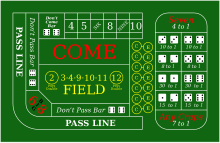To calculate the craps payouts and odds for this number, we multiply the three by two (the two dice that players use in the game), and the result we get is six. Thus, the odds are 1:6 and seven is the most frequent number that comes up in craps games. Limits on props are typically lower than what is posted for other bets (unless the table limits are given in terms of maximum payout) because of their higher payout odds. This particular house may have a $25 lid on the horn numbers, making a $100 horn high anything unbookable in the traditional sense. Craps Bet: Description: Payout Odds: House Edge: Pass Line: 7 or 11 on come-out, then the point: 1:1: 1.41%: Don’t Pass: 2 or 3 on come-out, then 7: 1:1: 1.36%: The Come Bet: 7 or 11 on come-out, then the point: 1:1: 1.41%: Don’t Come (Bar 12) 2 or 3 on come-out, then 7: 1:1: 1.36%: Pass / Come Free Odds: The point is 4 or 10: 2:1: 0.00%: The point is 5 or 9: 3:2: 0.00%: The point is 6 or 8: 6:5. Some beginner players find breaking the payout odds into units easier to quickly calculate payouts on winning bets. Looking at a craps table, the payout odds for landing a 4 are 9:5. This means that for every $5 bet you win, the dealer will pay you $9. Let's say you're at a craps table with a $10 minimum bet though.
- Payouts On Craps Bets
- How To Calculate Craps Payouts
- Craps Table Payout Chart
- Printable Craps Payout Chart
- Craps Table Payouts
Payouts On Craps Bets


How To Calculate Craps Payouts
The Names of the Positions at Craps
By Billy the Kid
Craps Table Payout Chart
Craps tables are of course divided in two halves each serviced by a 'base dealer'. The bets are booked and placed according to where a player is standing. To find out how and when the bets are paid please go to the odds and edges section on the front page.
Each half of the craps tables are also divided in half because the craps layouts are divided into box sections where the dealers place the bets and theses boxes must be kept in an orderly fashion so that the base dealer, box and stick can stay on the same page.
When you look at the placebet and comebet boxes you will see that there isn't enough room to put all of the bets in line so the dealers put the bets either on the front or back part of the number box. This brings us to how they determine a players position.
There is a split in the 'hook' where the table makes its first turn towards the base dealer ( sorry M this is 'the hook'). If a players chips are on the stick side of the middle of the hook their bet is placed in the front and conversely if the chips are on the base dealers side their bet goes in the back. You should note that it is where the players chips are placed that determines whether the dealer puts them in the front or back. As a side note if you have a jerk for a base dealer you can keep moving your chips from one side of the split to the other to drive him crazy, since he will have to move your bets back and forth from front to back each time you move your chips.
OK so there are players that the dealers say are 'in the front' and players that are 'in the back' and THIS is how they will relate to your playing position. If you are in the front next to stick (as we most often are) the base dealer will tell the stick you are his 'first', the stick will call you 'my first'. When paying a prop bet the stick will say $900 and still up to my first when he pays your $100 hard eight. When he pays the player that is standing next to the base dealer he will say $9 and still up to YOUR first to the base dealer. These descriptions of his and yours will move away from the dealers towards the hook.
So you can see that if you are in the front you belong to the stick and if you are in back you belong to the base dealer, and they say that you are their first, second, third or fourth moving around the table. There is never a fifth since the table size will only allow four in front and four in back. When playing next to the base dealer you will hear them handing you off to their next dealer as 'I have 3 in front 2 in back and my second has the hardways. On a stick change the leaving stickman will describe the shooters position as my first, in the hook, straight out, next to base or the bases first, second etc.
CIII I hope this is what you were looking for.
Billy the Kid